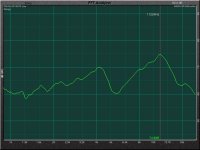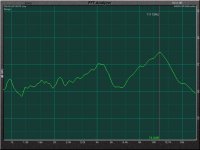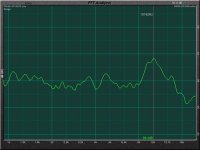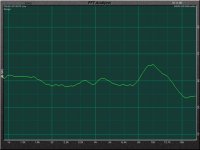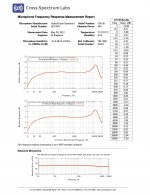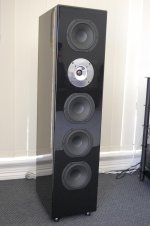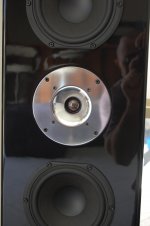For a nearfield measurement, that looks reasonable. The 500Hz/1KHz peaks are suppressed by the fact that the port is at the rear. Also, unlike sub-100Hz they are not emphasised by the room, so while they can look a bit disturbing, it's not that bad, seen a lot worse.
Of course, this tuning is definitely an area of experiment as these things interact with rooms etc, but overall response (2Pi) is meant to have Bessel like qualities as that suits a large number of rooms.
Thanks Joe. I was not really worried about those peaks. As you state, they seemed pretty inconsequential. I was mostly happy being able to take the measures in the first place and have them actually turn out useful. ;-)
I would very much appreciate your opinion on another set of measures. While I am able to measure the excess energy at 4k that has been the subject of the past few pages, the excess energy in my build seems to be quite a bit higher. I am seeing excess energy around ~11k when measured with the speakers in position in the listening area.
The first two pics are measures of the left and right speakers respectively, with the mic at tweeter height, 1m back. Pink noise averaged over a couple of minutes. 1/3 octave smoothing. While the excess energy at 4k is present, it is greatly dominated by excess energy at ~11k.
The last two pics, which represent two views of the same measurement, one with 1/3 octave smoothing and one with octave smoothing, are taken at the listening area where I normally sit. This measures was taken with the mic above tweeter height (~1000mm above the floor or 180mm above the tweeter axis). The mic is placed ~3m back from the speakers and equal distance between them. The speakers themselves are ~2m apart and only slightly toed-in (perhaps a couple degrees at most). In this position, the 4k energy is a non-issue, but the 11k energy is still quite prominent.
Any ideas or thoughts on what might be causing this excess energy at ~11k? I am using 1.8uf at C1 with the rest of the components as specified for the Mk V crossover. Could this just be room effects? Associated electronics? Something else entirely?
Thanks again Joe.
Attachments
I don't expect "room effects" give you a greater than 10 db peak in the treble range! Certainly not that peaky?
ARTA has a free demo mode, could you, perhaps do something like this?"
Place the mic about 3 inches away and take measurements at just low enough level so you are sure the mic is not clipping. Do that for the tweeters and each of the upper two woofers.
You could try both sin sweeps, and MLS measurements. Let's see what kind of peaks we see then?
ARTA has a free demo mode, could you, perhaps do something like this?"
Place the mic about 3 inches away and take measurements at just low enough level so you are sure the mic is not clipping. Do that for the tweeters and each of the upper two woofers.
You could try both sin sweeps, and MLS measurements. Let's see what kind of peaks we see then?
energy at ~11k.
It is hard to be specific, so some general comments instead.
The Nearfield measurement you did on the port are very easy to do, up to a certain frequency they are quite accurate, and with a 6.5" driver is mostly accurate up to 1KHz.
What you have attempted now is a Farfield system measurement, and they are fraught with difficulties. Unless you have a true anechoic room (and they sound terrible).
First, measuring at 1M is not ideal, also in room response is difficult to do and when I do use it, then it will be RTA pink noise tests. The 11KHz is way away from the crossover point and I won't assume or insult you and say have wired that wrong. It's also unlikely that you have two faulty tweeters.
The 1.8uF capacitor value has actually little affect above 10KHz.
The Elsinores are modelled on 2M, 15 degrees off axis and with a combination Farfield and Nearfield of the 6.5" drivers and Nearfield port, and at the height of the tweeter. Farfield measurements were done outdoors on a warm and not windy day, and careful windowing (time editing) to suppress reflections.
Later the final product is checked in room with RTA measurements at various different positions of the room, also with both single speakers and both on at the same time (then the pink noise generators must be different for each channel, no-coincident). I don't use MLS in room - impossible to edit out reflections etc.
I am not certain how much of the above is of value to you. Let me know.
You may want to try not having the 6.5" drivers on, only the Tweeter. Then move in on the Tweeter, say 0.5M, then window the time to cut out reflections of the room. The closer you get to the tweeter, the more you can window and cut out any effects/reflections the room has. The amplitude response may not be accurate, but that is not the aim here, the aim is to see if that peak in the Tweeter ameliorates or changes. Or if they made a bad batch, again very unlikely, but who am I to say.
Cheers, Joe R.
Last edited:
I don't expect "room effects" give you a greater than 10 db peak in the treble range! Certainly not that peaky?
Not sure what is going on. Bolser and Pate has done measurements and didn't get any 11KHz peak. Certainly no peak here when doing 'in room' RTA.
Not familiar with his equipment. I use Cliowin 10 which is as good as anything out there that I know off and most of the designers I know professionally use Clio (we threw away MLSSA some time back - I never could work it).
So anybody familiar with his equipment may be more helpful than I am.
Cheers, Joe
I will try. Thanks for the encouraging words. You like my speakers? Then I like you.
Cheers, Joe
I like your speakers very much! And I truly appreciate a designer of a superb speakers who chose to share it with the DIY crowd. Hopefully we helped you a bit in moving it to it's current state of excellent performance.
Joe, I wish you great financial success with your commercial designs.
Warm regards,
Francois
Any ideas or thoughts on what might be causing this excess energy at ~11k?
Are you using the calibration file for your CM-125 mic?
Many 1/4" condenser mics have a peak in the 10kHz - 12kHz range.
Perhaps that has something to do with it?
Do you have another loudspeaker with known flat response you can measure to see if the peak is related to the Elsinores or your measurement setup?
Are you using the calibration file for your CM-125 mic?
Many 1/4" condenser mics have a peak in the 10kHz - 12kHz range...
Do you have another loudspeaker with known flat response you can measure...
Some good suggestions there...
Thanks Joe, critofur and bolserst for the quick, detailed responses and helpful suggestions.
At this point I am working with the following comment:
Yes, I am using the calibration file. That said, there appears to be a bug in the FFT software of audioTools as it is not appearing to apply the calibration file(s) to the measurement. I have taken the measures with the calibration file(s) enabled and disabled and gotten the same results. As bolserst has pointed out, the mic has a serious peak at ~10-12k. The calibration file would have applied a calibration offset of up to 7.3db over that frequency range using the 1500 point narrow band calibration file. So, something is amiss. I have filed a bug report with the software vendor. We shall see what they say.
Thanks again for taking the time to make suggestions. They really helped to refocus the resolution to the measurement process.
BTW, manually applying the calibration factor makes those measures look far, far better.
At this point I am working with the following comment:
Are you using the calibration file for your CM-125 mic?
Many 1/4" condenser mics have a peak in the 10kHz - 12kHz range.
Perhaps that has something to do with it?
Yes, I am using the calibration file. That said, there appears to be a bug in the FFT software of audioTools as it is not appearing to apply the calibration file(s) to the measurement. I have taken the measures with the calibration file(s) enabled and disabled and gotten the same results. As bolserst has pointed out, the mic has a serious peak at ~10-12k. The calibration file would have applied a calibration offset of up to 7.3db over that frequency range using the 1500 point narrow band calibration file. So, something is amiss. I have filed a bug report with the software vendor. We shall see what they say.
Thanks again for taking the time to make suggestions. They really helped to refocus the resolution to the measurement process.
BTW, manually applying the calibration factor makes those measures look far, far better.
Attachments
Thanks again for taking the time to make suggestions. They really helped to refocus the resolution to the measurement process.
BTW, manually applying the calibration factor makes those measures look far, far better.
One thing I do to avoid wasting time with measurement setups, is to keep handy a known source. For me, it is a 3" Tang Band full range driver in a small sealed box. When starting a new project or measurement setup I always pull out the reference, measure it 1m on axis, and make sure response and sensitivity match with saved data. Then I know I can feel confident in the new data sets I acquire.
One thing I do to avoid wasting time with measurement setups, is to keep handy a known source. For me, it is a 3" Tang Band full range driver in a small sealed box...
Hi Steve
Interestingly I do something similar, but with a twist. I use a Vifa XT25 Tweeter which has a very flat on axis response and a recognisable roll-off below 1KHz. It is mounted flush on a panel (no box required) of decent size, but nowhere big as an IEC panel, set at 0.5M bang on the nipple. It must be flush or the response ain't flat.
It also allows me to do something else, it checks both that I am getting a consistent measurement that I recognise immediately and can also compare/overlay with a previous measurement, it also allows me to calibrate the dBSPL. I match the the two overlays, old and new measurements, then subtract -6dB and I have a calibrated setup relative to 1M/2.83V (1W nominally).
It doesn't take long and away we go...
Cheers, Joe R.
PS: That setup, within reason, also allows me to check mic response fairly well - quickly - as most of the deviations from calibration problems are within the range of the Tweter, above 1KHz.
Last edited:
Back in Black......... 4 coats of black 5 coats of clear and polishing.
Lots of beers to hand polish the wave guides turned out good,thanks again Joel.
WOW!
Wish mine looked like THAT!!!
Cheers, Joe R.
Back in Black......... 4 coats of black 5 coats of clear and polishing.
Lots of beers to hand polish the wave guides turned out good,thanks again Joel.
Stunning work spoonted! Absolutely beautiful.
Piano black speakers always have a certain elegance about them. They really turned out great.
I can only imagine the number of beers that gave themselves to the cause in the polishing of that waveguide!
WOW!
Wish mine looked like THAT!!!
Cheers, Joe R.
Stunning work spoonted! Absolutely beautiful.
Piano black speakers always have a certain elegance about them. They really turned out great.
I can only imagine the number of beers that gave themselves to the cause in the polishing of that waveguide!
Thanks for the kind words guys.
Nice to see polished waveguides..
Your Piano Black looks real good..
Can I email you for instruction? I'll try it on a pair of Joe's JR Mini
PM sent.
I googled Kef 104 and found this blurb on 104aB, this is what my friend at the time was attempting to clone:
www.hifiloudspeakers.info/Anatomy/KEFDocuments/KEF104abLeaflet/Kef104abXO.pdf
I found that a number papers actually lodged by Dave Dlugos, we are joined by the same umbilical cord called Vacuum State.
p12
The 'net not only makes the world smaller but also a time bubble.
Joe R.
anyone having that pdf ?
link is bloody nonfunctional

funny ZM
here it is : Explore KEF - Reference Series Model 104 - KEF International
sorry for OT
file with xo values attached
here it is : Explore KEF - Reference Series Model 104 - KEF International
sorry for OT
file with xo values attached
Attachments
Last edited:
- Home
- Loudspeakers
- Multi-Way
- The "Elsinore Project" Thread
